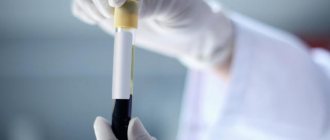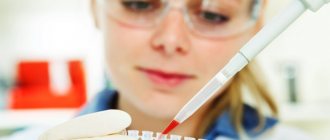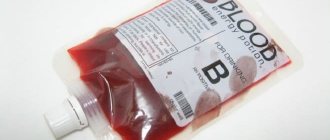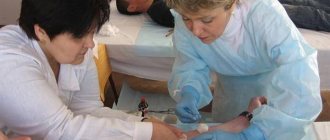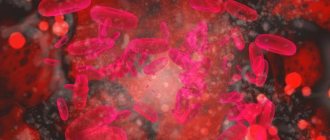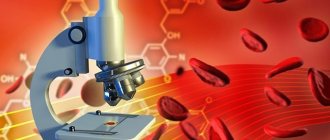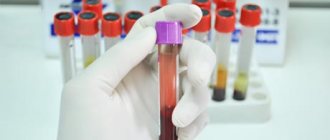What do you need to become a donor?
The division of blood into groups was carried out by the Austrian scientist Karl Landsteiner. Before this discovery, attempts at fluid transfusion were not always successful. Blood type is determined by group antigens (passed on by inheritance). It is customary to divide the indicator into 4 groups. One of them occurs most often.
Blood type rating:
- I positive – 37%.
- II positive – 36%.
- III positive – 9%.
- IV positive – 3%.
- I negative – 7%.
- II negative – 6%.
- III negative – 1%.
- IV negative – 1%.
Urgent blood transfusion is necessary for the following categories of people:
- after an accident or disaster, in the presence of serious burns, fractures, injuries;
- performing a caesarean section on women;
- the need for organ transplantation;
- presence of blood diseases;
- presence of intestinal obstruction;
- the presence of infectious sepsis.
A blood donor (donation requirements include weighing at least 50 kg) has positive and negative qualities. If the natural fluid is taken correctly, there will be no harm. The donor does good not only to another person, but also to himself.
Donating blood has a number of advantages:
- activation of hematopoiesis and independent blood renewal;
- reducing the load on the liver and spleen, as these organs remove dead red blood cells;
- strengthening the immune system;
- prevention of diseases of various organs - gastrointestinal tract, heart, blood vessels and others.
Negative qualities may appear when the procedure was performed incorrectly. Among the disadvantages is contamination of the donor’s blood. A high probability appears if the transfusion was direct. This measure is used only in rare cases. Blood donation is divided into types.
The classification is shown in the table:
| Name | Description |
| Autodonation | This is the preparation of your own biomaterial. The method is used before major surgery. When you administer your own blood, the likelihood of side effects decreases. |
| Whole blood collection | Venous blood is taken from a person and then injected into other people. |
| Plasmapheresis | The method is divided into manual and automatic. In the first case, a sterile bag is used to collect biomaterial. The blood is then divided into plasma and red blood cells. The final portion is then injected back into the donor. In the automatic type, a person is connected to a separator. The device takes whole blood and separates it into elements and plasma. The first portion is then automatically returned to the donor. |
| Thrombocytapheresis | Natural fluid is collected using a device. First, venous blood is taken, and platelets are isolated from there. The elements are necessary for people with tumors. |
| Granulocytapheresis | Another method is called leukocytapheresis. People who have severe infectious diseases need granulocytes. The collection is carried out similarly to plateletpheresis. |
| Collection of immune plasma | The donor is immunized with a strain of a specific infection. The body then produces protective antibodies. Venous blood is taken, immune plasma is isolated from it and transfused to patients who cannot independently cope with a similar pathogen. |
| Erythrocytapheresis | Red blood cells are needed for patients with anemia or other disorders that include a reduced hemoglobin level. Erythrocytapheresis is performed manually or automatically. The first method is similar to plasmapheresis. The only difference is that everything is returned to the donor except the red blood cells. |
Blood donor (requirements for donation include age category) is a person from whom biomaterial is safely taken. As a result of fluid loss, the body quickly recovers.
Not everyone can become a donor; the following conditions must be met:
- having Russian citizenship or living in the Russian Federation for at least 12 months;
- age category over 18 years old, but not higher than 60 years old;
- weight category not less than 50 kg;
- no contraindications.
If a person wants to become a donor, there are several subsequent steps that need to be taken. The algorithm for submitting biomaterial is indicated in the table.
| Name | Description |
| Filling out the donor questionnaire | Before donating biomaterial, the donor must fill out a form and provide the following information:
|
| Passing a body examination | After registration, you must undergo a full examination of the body, which identifies possible contraindications. A man is examined by a doctor. As a result, the value of pulse and pressure is determined. Blood is taken from a finger and a vein to determine important indicators (red blood cells, etc.). They also pay attention to the group, the Rh factor. Next, the doctor must approve the blood donation. |
| Blood donation | The offices have special chairs that provide a reclining position. This reduces the likelihood of dizziness. Algorithm for collecting biomaterial: 1. Applying a tourniquet to the forearm. 2. Feeling the intended place where the needle will be inserted. To accurately locate the vein, the health care professional asks the donor to clench and unclench his fingers several times. 3. Disinfection of the skin. 4. Inserting a needle into a vein. 5. Blood collection. 6. Removing the needle from the vein. 7. Applying a bandage. It will need to be removed after 2 - 3 hours. Some people believe that donating blood can cause infection. There is such a possibility, but it is minimal, since disposable and sterile instruments are used. In most cases, blood collection is painless. But if a person feels dizzy, it is necessary to inform the staff about this. The duration of blood sampling depends on the classification. Namely:
For any donation, 20 ml of biomaterial is taken and sent to the laboratory. All collected blood is examined according to the following indicators:
If the listed viruses were detected in the blood, the person is informed about this. After collecting the biomaterial, you need to sit for about 10–15 minutes. |
| Snack | Completion of this item is mandatory. You should not overload the gastrointestinal tract; drinking sweet tea with a bun is enough. Thanks to the fulfillment of this point, the person will feel good. Some organizations do not have a buffet, so you can take these products from home with you. |
| Getting help | The donor is given a certificate that gives the right to 2 days of rest. Weekends are paid in accordance with the Labor Code of the Russian Federation (Article 186). |
| Compliance with certain rules | After donating blood, you must adhere to certain rules. With this you can quickly alleviate the condition. Rules:
|
Requirements for blood donors
Donation is a voluntary, legal donation of blood, which will then be used for transfusion to patients or for fractionation, that is, the manufacture of medicines. The law established certain requirements for donors, and such requirements may vary in different countries, although in general the conditions are approximately the same.
The main requirement in Russia is good personal health, and there is also an age limit: he must be more than 18 years old. In addition, there are also weight requirements: it must be 50 kg or more. To donate blood, a person must have a passport and other documents, and he is also obliged to report possible infectious diseases and his use of psychotropic substances, in accordance with the requirements of Russian law.
Types of donation:
- Autodonation
- Whole blood donation
- Donor plasmapheresis
- Thrombocytapheresis
- Granulocytapheresis
- Immune plasma
- Erythrocytapheresis
The donor may also need to undergo a general physical exam and have their blood tested, which will allow doctors to determine whether the person is healthy and suitable for donation. They have also now begun to conduct additional surveys required to compile a medical history of the future donor. Such information will be very important in order to find out whether a given person is suitable for donating blood in the future.
Donating blood can make a person feel nauseous, stressed, and even faint, although donation itself is definitely safe. Such general side effects will disappear within 1–2 hours or a day after the donation itself.
The donor must be a volunteer and independently accept the desire to donate blood; before that, he must tell about his diseases and contacts with various patients. You need to talk about being near areas where the infection was spreading and there were epidemics, that is, widespread various diseases. Doctors will have to obtain information about the work of the future donor under hazardous working conditions, as well as about the surgical operations that such a person has had, in addition, he must know that he is responsible before the law of the Russian Federation.
How often can you donate blood?
Donation has limitations. That is, you can donate blood a certain number of times a year. For men, this figure is 5, and for women – 4. Depending on the type of donation, there are minimum intervals that must be adhered to. They are listed in the table.
| Initial procedure | How long after the subsequent procedure can be performed (in days) | |||
| Whole blood | Plasmapheresis | Thrombocytapheresis | Leukocytapheresis | |
| Whole blood | 60 | 30 | ||
| Plasmapheresis | 14 | |||
| Thrombocytapheresis | ||||
| Leukocytapheresis | 30 | 14 | ||
Privileges, guarantees and benefits for blood donors
Regular gratuitous donation is not only an opportunity to learn about your health, earn money and receive meals; it is also an honorary title. The title of honorary donor of Russia is given to those who have already donated free blood more than forty times, and plasma 60 times or more. Already this year, Russian law has provided donors with such benefits as a free trip to a sanatorium for recovery and treatment. Also, if the day of blood donation coincides with various holidays or a day off, then the donor already receives two days off, where the second day is at a double rate.
To have more benefits, you should donate blood 40 times, and plasma 60 times; if this was done free of charge, then the title will be accurate. The donor can still get a vacation once a year, when it is convenient for him, and when receiving medical care, the person will be able to go without queues. In addition, a person who has received the title of honorary donor of the Russian Federation can still receive assistance once a year in the form of a sum of money in accordance with Article No. 24. Only in 2013, the amount of the annual donor payment was 11,138 rubles, such an indexation of the amount is done every year and is now equal to 11,728 rubles
Advice from psychics on how to attract money to your home.
7 ways where you can really and quickly make money on the Internet: read more.
Top 5 online games where you can earn real money: https://money-budget.ru/earn/online/top-5-onlayn-igr-gde-mozhno-zarabotat-dengi.html
Contraindications
Donation has contraindications. If certain factors are present, a person cannot donate blood. They are divided into absolute and temporary. The first type includes serious diseases. Temporary contraindications have different periods. That is, a person cannot become a donor for a certain period of time. Contraindications are indicated in the table.
| Group of contraindications | Description |
| Absolute | You cannot become a donor in the following cases:
|
| Temporary | Temporary contraindications include the following:
|
Can it be a permanent income?
No, he can not. Blood can be donated no more than five times for men and four for women. Payment for one transfusion is no more than five thousand rubles.
The break between retakes must be at least thirty days. That is, monthly for five months no more than five thousand. This is not suitable for a permanent source of income.
Such income is more likely to be one-time when money is needed here and now.
See how to extend vacation time during sick leave by order. How to log into your personal government services account via SNILS? The answer is in the link.
How to queue for kindergarten through government services? Find out further.
What not to do before taking the exam
Before collecting biomaterial, the following preparatory rules are required:
- For 3 days, it is better to exclude medications that contain acetylsalicylic acid (aspirin) and analgesics - Nurofen, Ibuprofen, Analgin.
- Stick to proper nutrition for 2–3 days. It is recommended to eat 5 – 6 times a day (portions should be 200 – 300 g) with breaks of 3 – 4 hours. Salty, smoked, fried foods should be removed from the diet. It is better to replace high-fat products with low-calorie ones (milk, meat). It is necessary to exclude chocolate and flour. Food should be steamed or oven-baked. You should add cereals, vegetables and fruits (except bananas) to your diet.
It is recommended to drink at least 1.5 liters of clean water per day.
Juice, fruit drink, compote are allowed.
- Eliminate smoking and drinking alcohol for at least 2 days.
- The day before donating blood, you should not put too much stress on your body.
- In the morning before the procedure, a light breakfast is necessary; you should not overload the gastrointestinal tract.
- Before the procedure, you can drink tea with sugar.
Transfusion Basics
You need to understand that in the modern medical world it is forbidden to transfuse, unless absolutely necessary, blood that differs from the recipient’s group. It is completely prohibited and has an excellent Rh factor. Ideally, the transfusion should be the same type as the recipient.
The Rh factor in donation is an important indicator that is passed on to children by inheritance. It is located in blood components, various organs, and amniotic fluid. When a person who has a negative Rh factor is transfused with a positive type, the body begins to produce specific antibodies. We can say that the body is protecting itself from something foreign.
Often becomes a problem for bearing a child.
Therefore, pregnant women with negative Rh, if their husband has a positive one, are examined more thoroughly.
You can be sure that if not the first, then the second transfusion can be fatal for a person with a different Rhesus blood from the blood being transfused. It is also worth emphasizing that in people with positive Rh, it can be of several types or one. That is, you can see a combination of different types, which is also important to consider when transfusion. Therefore, it is important to determine what kind of blood the recipient has and what kind of blood the person who donated the material has.
In most cases, modern doctors identify six antigens in the Rh factors of two systems. In humans, the presence of both systems or only one can be distinguished.
At the moment, almost three dozen combinations have been identified in laboratory studies. Before performing a transfusion, the presence of Rh is determined, as well as an analysis for Rh compatibility. Returning to the question of the best type, doctors note that, by and large, this type does not exist.
The fact is that rare phenotypes do not indicate that they are particularly in demand, because if a phenotype is rare, we can say that it will be useful to fewer people.
Experts involved in transfusion issues are confident that it is wrong to consider rare groups as bad. Every day, the clinics’ need for certain components and blood of a specific group changes. Therefore, a situation often occurs in which the rarest thing on that day turns out to be the most common. This is why doctors encourage all healthy people to donate, regardless of their group or Rh status.
Designated by the absence or content of special substances (antigens) of type A and B: I – 0 (antigens are absent), II – A (type A antigen is present), III – B (type B antigen is present in the blood), IV – AB (contains both types of these substances).
Blood is also classified according to the presence or absence of the Rh factor. Rh factor is an antigen found on the surface of red blood cells. The rarest is determined by both indicators. According to statistics, the fourth with a negative Rh factor has this status. Less than one percent of the planet's population (mostly) has it.
It is allowed to transfuse only blood of the same group and rhesus between the patient and the donor. If absolutely necessary, it is allowed to transfuse other groups with the first blood group, which has the same Rh factor.
Conditions for receiving the title “Honorary Donor”
A blood donor (donation requirements include residence in Russia for at least 1 year) can become an honorary blood donor. When a person has submitted the required amount of biomaterial, a specialist from the institution informs about the possibility of obtaining a title. To do this, you need to provide an identification document and a certificate from the institution.
You can fill out an application in your personal account on the State Services portal. The package of documents is submitted to social protection or the MFC or through the State Services portal. If employees have no doubts about the certificate, after 1–3 months they can receive a certificate and badge.
You can receive the title “Honorary Donor” if a person donates a certain amount of blood. Detailed information is shown in the table.
| City | How many times does a person need to donate blood to receive the title? | |||
| Whole blood | Plasma | Whole blood (in larger quantities) and plasma. | Whole blood (in smaller quantities) and plasma. | |
| All around Russia | 40 | 60 | More than 25 times blood, and plasma up to a total of 40 times. | Less than 25 times blood, but supplement with plasma for a total of 60 times. |
| Moscow | 20 | 30 | More than 13 times blood and 20 plasma. | Less than 13 times blood and 30 times plasma. |
| Saint Petersburg | 20 – 40 | 30 – 60 | 10 times blood, and plasma up to a total amount of 30 - 60 times | 10 – 25 times blood, and plasma up to a total amount of 20 – 40 times. |
If a person donates any component (red blood cells, etc.), this is equivalent to whole blood.
How much does it cost to donate blood and plasma as a donor?
Russian legislation has decided to eliminate various monetary rewards for blood donors. This was done back in 2013, and it is explained simply, that is, in many countries of the world, blood donation will be carried out free of charge. This cancellation is also due to the fact that now the quality of blood in medical banks will be of better quality and donors will forget about easy money. That is, those who are in good health will donate blood free of charge, although the old reward remains for the 4th blood group of negative Rh.
Only by 2014 were special coupons with a comprehensive good lunch introduced, and the donor was also able to receive coupons for the purchase of a number of products, the cost of which would already be 435 rubles. A donor who donates plasma in a volume of 600 ml today receives an additional 1,330 rubles, and when donating blood components, he receives a coupon and 554 rubles.
Cost of donating blood and plasma:
The Moscow Department established order No. 414 of 2013, which indicates the amount of bonuses:
- blood with a rare phenotype - 800 rub. for 450 ml,
- plasma 600 ml - 1500 rub .,
- platelets - 3500 rub .,
- red blood cells - 2500 rub. and more.
Here are the prices, how much it costs to donate blood and blood plasma in Moscow and the Moscow region. In regions, the fee will be different, that is, compensation in certain amounts is added to the base payment. Only in St. Petersburg, active donors who donate blood three times a year will be able to receive, in addition to the lunch itself, an additional amount of money in the amount of 554 rubles.
Benefits, privileges and cash payments
A blood donor (donation requirements include being at least 18 years old) can enjoy various benefits.
They depend on the category of person:
- with the status of an honorary donor;
- worker;
- pensioner.
Honorary
The following benefits are available to honorary donors:
- emergency treatment in institutions;
- the opportunity to receive a free voucher to a sanatorium or on vacation in an extraordinary manner;
- annual paid leave whenever the donor wants;
- payment every year - the amount in 2020 was equal to 13,562.78 rubles, and additional payment for the region is also possible;
- It is possible to receive regional benefits, for example, a discount on medicines of up to 50% (not in all regions).
There are additional benefits for Moscow.
Namely:
- the possibility of free travel with a social card;
- payment for housing and communal services with a 50% discount;
- purchasing medications at a discount;
- free installation of dentures.
Working
Working donors have a number of privileges.
Namely:
- Issuance of a certificate after donating blood, which gives the right to 2 days off. Everything is paid, even if the person had a non-working day according to the schedule. It is possible to use the weekend immediately or leave it to extend your vacation. If after donating blood a person feels well, you should agree with management so that the company will give rest at another time. If a certificate is provided after each successful donation, then after 10 donations you can earn practically a vacation, which is equal to 20 days.
It must be remembered that it is not possible to exchange days off for payments.
- Issuance of cash for food. The amount varies from 500 to 1000 rubles, depending on the region.
- Discount tickets without waiting lists. If a person is a donor, he can receive a vacation or medical voucher from his employer. But the point is fulfilled if a person donates blood more than 2 times in a year.
- Payment by the employer for the days when the donor donated blood (in accordance with the average salary). Moreover, they are included in the total length of service.
Upon retirement
Often there are no additional benefits with retirement. But older people can use a social card, which gives a discount on transport, and doctor’s help is also available without waiting in line. Honorary donors cannot retire early. But all the benefits that were available remain (medical care, cash payments).
For conception
In the matter of conceiving and bearing a child, the question of the Rh factor comes first. Approximately 85% of Europeans have a positive Rh factor. If a man and a woman have different Rh factors, then the health of the pregnant woman must be taken seriously. If the child inherits the mother's Rh factor, there will be no problems. If there is a Rhesus conflict, a miscarriage may occur without medical help.
Important information: How to determine the gender of the unborn child based on the blood type of the parents and calculate from the table who will be a boy or a girl
Thus, the best blood group for conception will be one that matches the Rh factor in a man and woman.
Procedure for applying for benefits
In order for an honorary donor to receive benefits, you must visit the social security office or the MFC.
You need to take the following documents with you:
- passport of a citizen of the Russian Federation;
- application for benefits;
- “Honorary Donor” certificate;
- name of the account that will be needed to transfer funds.
The process of blood donation is useful not only for society, but also for the citizen himself. The procedure has a large number of advantages - reducing the load on many organs, strengthening the immune system. But before donating blood, you need to take into account all the requirements. For example, age category over 18 years, weight more than 50 kg, etc. As a result, the donor may become an honorary donor.
If a person donates a certain amount of blood (depending on the region), he is given a badge and a certificate. Upon receiving the title, additional benefits appear in the form of cash equivalent, which is paid every year, as well as other privileges.
Article design: Vladimir the Great
What is the best blood type?
The most common blood type classification today is the ABO system.
There are only four blood groups: 0 (first), A (second), B (third) and AB (fourth). Another important blood characteristic is the Rh factor (Rh), which can be positive or negative. The question of a particular person’s blood type usually arises before serious medical interventions or after severe blood loss. The donor and recipient of a blood transfusion must have compatible blood types. People with blood type O have long been called “universal donors” because their blood is suitable for transfusion to people with any other blood type.
However, in practice such transfusion is allowed only in desperate situations in the absence of blood of the same type as the recipient.
Previously, it was also believed that people with the fourth blood group are universal recipients, that is, blood of any other group is suitable for them
Modern blood transfusion standards require that the donor and recipient have the same blood not only according to the group in the ABO system, but also with the same Rh factor. Exceptions are possible, but only in cases of particular urgency and urgent need. In such cases, it is permissible to transfuse blood of a different but compatible group, and in an amount of no more than 500 milliliters.
In this context, the best blood type is the one that flows in the bodies of the greatest number of people, so that if necessary, a compatible donor can be easily found. The most common blood group is the first (45%), the owners of the second group are about 35% of the world's population, the third and fourth are found in approximately 13 and 7 percent of the world's inhabitants, respectively.
Thus, if you look at blood group from the position of “best = most common”, then the undisputed winner is the first blood group
Objectively speaking, there is no better blood type or, conversely, a worse one. We have to talk about this only in the context of a possible blood transfusion. If such a situation arises, the easiest way is to find a donor with the most common blood type - first. But in fact, it is now quite easy to get blood of any type you need, because blood transfusion stations are constantly replenishing their supplies.
Today, in the world, human blood is classified according to the ABO system, as well as the Rh factor. According to this classification, a person can have one of four groups:
- the first is designated by the number 0;
- the second letter A;
- the third letter B;
- the fourth is a combination of their AB.
Moreover, everyone can have. Accordingly, human blood can be divided into four groups or eight types. In this regard, the question often arises, which is the best.
Most often, the question of which blood is the best arises when it comes to donation. That is, it is assumed that it is best to have the type that occurs most often. That is, the most common blood should be the best, but is this really so?
The most common all over the world, according to research, is the first. About half of the world's inhabitants have this type. In second place is the second one. About forty percent of people have it. The fourth is the smallest. Only two percent of people have it, and the remaining eight come from a third. Thus, the most common option is the first or second group.
However, it is necessary to take into account not only the group, but also the Rh factor. For most people, about 85 percent, it is positive. By and large, this means that the Rh factor is present in the blood. The remaining 15 percent do not have it, that is, we are talking about the Rh factor being negative. From this, many conclude that the best blood is the first positive, since it is easiest to find, and the worst is the fourth negative.
The first group can also be classified as universal.
It is believed that it can be used for donation for any person, since it does not have antigens A and B. Accordingly, the recipient’s body will not perceive the blood as something foreign. Therefore, the first group is considered one of the best for donation. Since it can be transfused to anyone, it means that almost anyone can be saved by it.
But, despite the fact that this group is very popular, its owners can only be transfused with the same first group. At the same time, the fourth group, which is not the most popular, is capable of accepting any type, due to the absence of antibodies to antigens A and B in the plasma.
How did the fourth blood group appear?
According to scientists, in ancient times almost all people had one blood type - the first, and therefore it is the most common on most continents. Thanks to mutations, the second and third blood groups arose. Such mutations arose due to the restructuring of the primitive organism, which learned to eat, in addition to meat, fish, berries, leaves, and vegetables. According to scientists, the third blood group appeared on the territory of South Asian countries, whose inhabitants ate products obtained from animals (milk, cottage cheese, cheese, thermally processed meat, and so on).
The rarest fourth group appeared no more than 10 centuries ago; its origin remains unknown. However, there are suggestions that it arose as a result of race mixing. Since such marriages are a phenomenon, there are very few people with the fourth blood group. There is also an opinion that this type of blood appeared due to a significant increase over the past five hundred years in the human diet of processed foods, as well as synthetic and semi-synthetic foods.
According to one version, the fourth blood group was formed as a result of damage to the human body by viral infections.
People with the fourth have a unique ability to adapt to nutritional conditions and the environment, and their body has a high resistance to diseases. Such people have a sensitive digestive system and a very tolerant immune system.
Blood loss is a dangerous phenomenon, fraught with a sharp deterioration in health and death. Thanks to advances in medicine, doctors are able to compensate for blood loss by transfusion of donor biomaterial. Transfusions must be carried out taking into account the type of blood of the donor and recipient, otherwise the patient’s body will reject the foreign biomaterial. There are at least 33 such varieties, of which 8 are considered basic.
